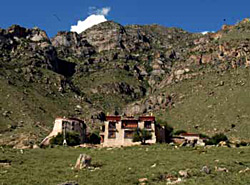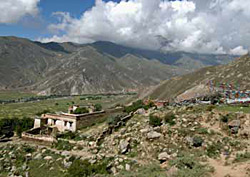Introduction
 A view of PabongkhaPha bong kha from the south. |  A view of PabongkhaPha bong kha from the rear, looking down into the NyangdrenNyang bran Valley. |
PabongkhaPha bong kha, one of the largest and most important of the SeraSe ra hermitages (ritröri khrod), lies about eight kilometers northwest of downtown LhasaLha sa on the southern (LhasaLha sa-facing) slope of a peak known as Mount Parasol (UdukriDbu gdugs ri), northwest of SeraSe ra. It takes a little over one hour to walk from PabongkhaPha bong kha to SeraSe ra. PabongkhaPha bong kha is the starting point for the “Sixth-Month Fourth-Day” (Drukpa TsezhiDrug pa tshe bzhi) Sera Mountain Circumambulation Circuit (Seré RikhorSe ra’i ri ’khor) pilgrimage. To see images of the circumambulation taken in 2002, click here.
The site has a long history that is said to go back to the time of the first Buddhist king (of Tibet) Songtsen Gampo (Chögyel Songtsen GampoChos rgyal srong btsan sgam po).2 Although originally the site of his castle (kukharsku mkhar) or fort, it appears that PabongkhaPha bong kha was quickly converted into a monastery, perhaps as early as the reign of the second great Buddhist king (of Tibet) Trisong Detsen (Chögyel Trisong DetsenChos rgyal khri srong lde’u btsan). The monastery was partially destroyed as part of King LangdarmaGlang dar ma’s (d. 842) campaign to dismantle monastic Buddhism. During the so-called “later propagation period” (chidarphyi dar), PabongkhaPha bong kha was taken over by members of the KadampaBka’ gdams pa school. Later, TsongkhapaTsong kha pa (1357-1419) lived at the site as a hermit, and it eventually became a GelukDge lugs institution. Before 1959, PabongkhaPha bong kha was apparently an autonomous institution that belonged to no other monastery, although at various times it has had informal ties to SeraSe ra through the person of the various SeraSe ra lamabla mas that served as its abbots. The monastery suffered considerable destruction from 1960 to the mid-1980s. SeraSe ra monks began renovating the buildings in the mid-1980s, and today the monastery belongs to SeraSe ra. Since the mid-80s, all of PabongkhaPha bong kha’s monks are SeraSe ra monks, and the hermitage is managed by a senior SeraSe ra monk. As was the case before 1959, and as is typical of the SeraSe ra hermitages in general, PabongkhaPha bong kha is principally a ritual institution. It maintains its own tradition of monthly and yearly ritual cycles.3 The most important of these yearly ritual events (at least for the laity) are:
- the six-day (three sets of two-day) Avalokiteśvara fasting rituals (nyungnésmyung gnas) that take place during the time of the Tibetan New Year (LosarLo gsar) celebrations,
- the sixteen-day (eight sets of two-day) Avalokiteśvara fasting rituals that take place during the fourth Tibetan month. This attracts many (especially elderly) people from LhasaLha sa and the surrounding area, and
- the ritual and other events that take place during the “Sixth-Month Fourth-Day” pilgrimage.
The title of the KarchakDkar chag reads Yul nyer bzhi’i ya rgyal/ de bi ko ṭi dang ming gzhan pha bong kha byang chub shing gi nags khrod du bkod pa’i dkar chag dad ldan padmo rgyas byed gzi sbyin ’od stong ’bar ba’i nor bu (hereafter Pha bong kha’i dkar chag). It appears to be an edited version of a text bearing the same name published in Three Khrid on the Nā ro mkha’ spyod Practice (Delhi: Ngawang Sopa, 1976), 454-532. (I have Gene Smith to thank for making a copy of this latter edition available to me.) References to the Dkar chag in this work are to the edition published in Tibet. The publication of the Tibetan edition of the Dkar chag was sponsored by a contemporary abbot (or perhaps now former abbot) of PabongkhaPha bong kha, Jampa Tupten RinpochéByams pa thub bstan rin po che.
In the colophon the author of the KarchakDkar chag identifies himself as the reincarnation of a LamaBla ma of Kongpojo DzongKong po jo rdzong, the reincarnation of the LamaBla ma of Chökhang Tsewa Monastery (Chökhang Tsewa GönpaChos khang rtse ba dgon pa); he also identifies himself as belonging to the Mé College (Dratsang MéGrwa tshang smad) of SeraSe ra, but gives his name only in Sanskrit as Wāginḍamatibhadrapaṭu bandashāsadharasagara (sic).
The introductory verse of the Delhi edition bears identifying marks (dots) under certain syllables. (These are missing in the Tibetan edition.) Those marks spell out “Ngawang Lozang Tupten Gyatso Jikdrel Wangchuk Choklé Nampar GyelwaNgag dbang blo bzang thub bstan rgya mtsho ’jigs bral dbang phyug phyogs las rnam par rgyal ba.” This resembles the name of the eighth Demo incarnation Ngawang Lozang Tupten Jikmé Gyatso (Demo Kutreng Gyépa Ngawang Lozang Tupten Jikmé GyatsoDe mo sku phreng brgyad pa ngag dbang blo bzang thub bstan ’jigs med rgya mtsho, 1778-1819), tutor of the Ninth Dalai Lama (Dalai Lama Kutreng GupaDa lai bla ma sku phreng dgu pa, 1806-1815).
The colophon tells us that the work was written between the female-fire-pig (MemopakMe mo phag) and male-earth-bird (SapojaSa pho bya) years. In the fourteenth calendrical cycle or RapjungRab byung, this corresponds to 1827-1828. The author of the Dkar chag further states that he based his work on a verse text compiled by KhardowaMkhar rdo ba (mkhan thog brgyad pa kha rdo sku thog bzod pa rgya mtsho’am/ blo bzang sgom chung pas bsgrigs pa tshig bcad ma), as well as on the constitution (ChayikBca’ yig) of the monastery written by Tatsak Yeshé Tenpé GönpoRta tshag ye shes bstan pa’i mgon po (1760-1810). On Khardo Zöpa GyatsoMkhar rdo bzod pa rgya mtsho (1672-1749) see the Introduction to the Hermitages. On Tatsak Yeshé Tenpé GönpoRta tshag ye shes bstan pa’i mgon po, see TBRC P302.
Still unavailable, to my knowledge, are: (1) the KarchakDkar chag of PabongkhaPha bong kha in six folios written by Khardo Zöpa GyatsoMkhar rdo bzod pa rgya mtsho, and (2) another KarchakDkar chag by Khöntön Peljor Lhündrup’Khon ston dpal ’byor lhun grub (1561-1637). The latter is mentioned in Akhu RinpochéA khu rin po che’s (1803-1875) list of rare texts; see Lokesh Chandra, Materials for a History of Tibetan Literature (Kyoto: Rinsen Book Co., 1981, repr. of the 1963 ed.), no. 11012. Bshes gnyen tshul khrims, Lhasé Gönto Rinchen PunggyenLha sa’i dgon tho rin chen spungs rgyan [A Catalogue of the Monasteries of Lhasa: A Heap of Jewels; hereafter Lha sa’i dgon tho] (Bod ljongs mi dmangs dpe skrun khang, 2001), 15, quotes Khöntön’Khon ston’s KarchakDkar chag, implying, perhaps, that he had the text at his disposal; he gives the date of composition of the work as 1619.
Sde srid sangs rgyas rgya mtsho’s account of PabongkhaPha bong kha in the Baidurya SerpoBai ḍūrya ser po, 144, is fascinating because it links the flourishing of Tibet to the flourishing of PabongkhaPha bong kha; and vice versa, it links political problems in Tibet with the decline of PabongkhaPha bong kha. Mention of PabongkhaPha bong kha is also found in Turrell Wylie, The Geography of Tibet According to the ’Dzam-gling-rgyas-bshad (Rome: IsMEO, 1962), 83 and 159 n. 400; and Alfonsa Ferrari, Luciano Petech and Hugh Richardson, Mk’yen brtse’s Guide to the Holy Places of Central Tibet (Rome: IsMEO, 1958), 42, 101-102 n. 86, and plates 6 and 7.
Hermitages Home
Table of Contents
- Introduction
- Location and Layout
- History
- Glossary
- Notes
- Specify View:
- Specify Format:
 |  |  |